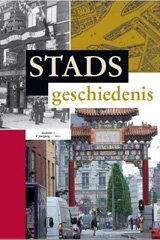Stadsgeschiedenis editie 2011 - 1

|
Julie De Groot Ben Hermans Els Vervloesem Essay Ching Lin Pang (Review) Maarten F. Van Dijck e.a. (Review) Inge Bertels en Bart Tritsmans |
Abstracts
Julie De Groot, Late medieval domestic service reconsidered. Servant girls in fiffteenth century Ghent
This article aims to reassess the meaning of a life-cycle servanthood for young, unmarried women in late medieval Ghent. Instead of accepting the widespread idea that life-cycle servanthood in medieval cities was nothing more than the lowest occupation for younger women, except for prostitution, it is our hypothesis that it should rather be perceived as a period of further education, in which girls are formed by their master and/or mistress, who were often relatives. Wills of employers and household accounts reveal the likelihood that a lot of young servant girls were given the opportunity to accumulate knowledge and skills, wages and cloth for their future bride’s trousseau. As a result, servanthood was also a kind of preparatory phase for later life and future marriage.
Ben Hermans, Experienced Migrants? The role of individual and family migration experience within regional migration patterns towards Antwerp in the second half of the nineteenth century
This article focuses on migrants’ places of origin, rather than their place of destination, in order to reconstruct the migration history of individual emigrants and their family members (parents and siblings). The geographical focus is on regional migration patterns from the Campine area towards the city of Antwerp. Through a comparative in-depth analysis at the micro level, this article argues that migration intensity is a proxy for very dissimilar forms of migration information channels. Despite equal emigration intensity, migration patterns can differ strongly
under the infl uence of individual and family migration experience.
Els Vervloesem, Western fi ction or Chinese masquerade? The social construction of Chinatown during the Rotterdam v.v.v.-week (1935)
In 1935, the initiative for a Chinese themed festival in Katendrecht marked a key moment in the history of Rotterdam’s Chinatown. This event instigated the metamorphosis of Katendrecht as an isolated and self-suffi cient enclave of the Chinese community, depending exclusively on the harbour industry, into an attractive entertainment centre for a broad, international public.
Hereby, it forecasted the current worldwide success of Chinatowns as tourist ethnoscapes. Drawing on historical newspaper articles, photos and movies, this article aims to demonstrate the mediating role of discursive and material representations of migrants in urban transformation processes.
Ching Lin Pang, Migrant girls in and out of South China. No time to be unhappy
This essay aims to capture the mood and the actually lived experience of China’s migrant girls. In its textual presentation it mixes a scholarly discussion of existing literature with biographical reminiscence of the author. Migrant girls take centre stage in this essay as they are trying to come to terms with the harsh but opportunity-rich city life and the prevalent Chinese gender role of dutiful daughter